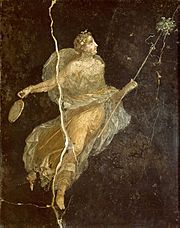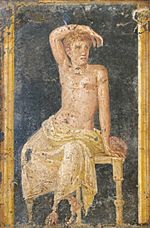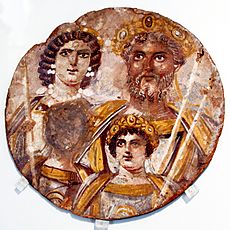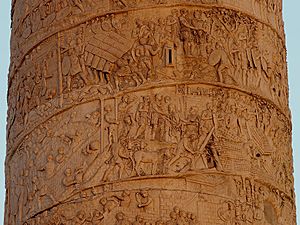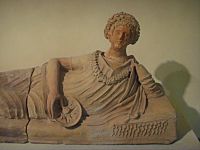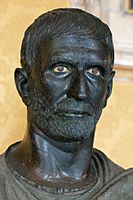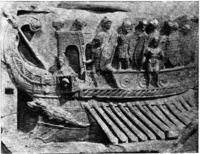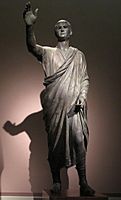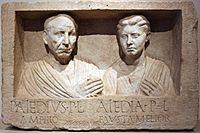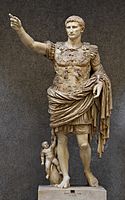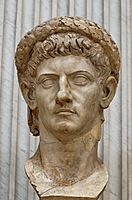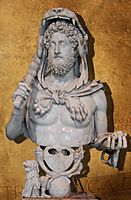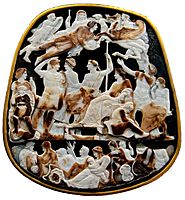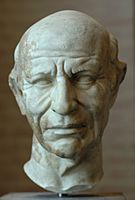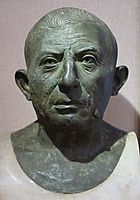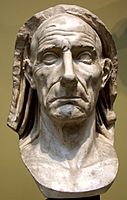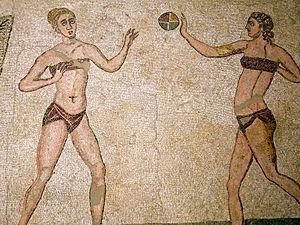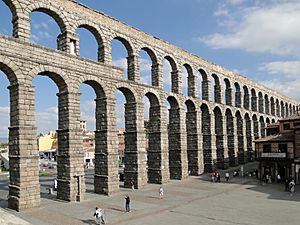Roman art facts for kids
Roman art is the amazing artwork created by the Romans and in the lands they ruled, like the Republic and later the Empire. This includes their buildings, paintings, sculptures, and mosaics. Fancy items made of metal-work, carved gems, ivory carvings, and glass were also important.
The Romans thought sculpture was the highest form of art, but they also really liked figure painting. We have many sculptures from about 100 BC onwards, but not much painting has survived. Most of the paintings that remain probably weren't considered the very best by people living back then.
Ancient Roman pottery wasn't a luxury item. However, a lot of "fine wares" called terra sigillata were decorated with cool designs that showed the latest styles. This meant many people could afford stylish objects. Roman coins were also a big way for the government to spread messages, and tons of them still exist today.
Right image: A fresco of a young man from the Villa di Arianna, Stabiae, 1st century AD.
Many people used to think that Roman artists mostly copied Greek art. It's true that many Greek sculptures we see today are actually Roman marble copies. But more recent studies show that Roman art was very creative. It took ideas from Greek art but also from Etruscan, native Italian, and even Egyptian styles. Roman art often mixed different styles and was very practical.
Pliny, a famous Roman historian, wrote that the Greeks were ahead in many art forms like sculpture, landscape, and portrait painting. While we don't have much Greek wall art, Greek sculpture and vase painting certainly support this. Roman artists probably didn't surpass the Greeks in design or skill. Pliny also mentioned a Greek painter named Peiraikos who painted everyday scenes like barbershops and donkeys. These paintings were very popular and sold for high prices, even though they showed "common" subjects.
Many Roman artists came from Greek areas. The large number of Roman copies of Greek art shows how much Romans admired Greek art. Many art forms and methods used by Romans, like different types of relief, free-standing sculpture, mosaics, and portrait painting, were first developed or improved by Ancient Greek artists. One unique Roman art form was the Roman bust, which showed only the head and shoulders.
Unlike Greek artists who were highly respected, most Roman artists were unknown and seen as tradesmen. We don't have records of great Roman art masters, and very few signed works. While Greeks focused on the beauty of art and wrote about art theory, Roman art was more about decoration and showing off wealth.
Roman cities were much larger than Greek city-states. Because of this, art in Ancient Rome had a wider and more practical purpose. Roman culture took in many different cultures and was usually open to the ways of conquered people. Wealthy Romans were very materialistic. They decorated their homes with art and objects, and wore fine jewelry.
In the later Roman Empire (from 350 to 500 CE), wall painting, mosaic work on ceilings and floors, and tomb sculptures were very popular. However, large free-standing sculptures and panel paintings became less common, probably for religious reasons. When Emperor Constantine moved the capital to Byzantium (renamed Constantinople), Roman art started to include Eastern influences, leading to the Byzantine style.
Contents
Painting in Ancient Rome
We only have a few examples of Roman painting left today. The most important ones are the wall paintings from Pompeii, Herculaneum, and other nearby places. These paintings show how wealthy people decorated their homes in the century before the Mount Vesuvius volcano erupted in 79 AD. Art historians have studied these paintings and identified different "Pompeian Styles" that show how the art became more detailed over time.
Wall paintings from the same time have also been found in important homes in Rome, like parts of Nero's palace, the Domus Aurea. These paintings, found in underground rooms, inspired the "grotesque" style of painting that was popular during the Renaissance. We also have murals from the homes of Emperor Augustus and his wife Livia, dating to the early 1st century AD.
Outside Italy, many painted wall fragments have been found across the Empire, but few complete pieces. From Roman Egypt, we have many Fayum mummy portraits. These are portraits painted on wood and attached to mummies. They give us a good idea of what Roman painted portraits looked like, as most others are lost.
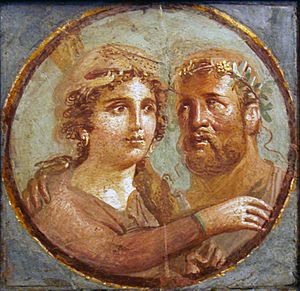
From the 3rd century AD to about 400 AD, we have many paintings from the Catacombs of Rome. Not all of these are Christian. They show how the tradition of decorating homes continued in burial chambers, probably for less wealthy people.
We don't have any of the Greek paintings that were brought to Rome, or any of the paintings on wood made in Italy during that time. So, the paintings we have only cover about 200 years out of Rome's 900-year history, and they are mostly provincial or decorative.
Most of these wall paintings were done using the a secco (dry) method, where paint is applied to dry plaster. Some fresco paintings (paint applied to wet plaster) also existed. Romans didn't have a tradition of painting on vases like the Ancient Greeks did.
Variety of Subjects in Roman Painting
Roman paintings show many different things: animals, still lifes, scenes from everyday life, portraits, and stories from mythology. During the Hellenistic period (when Greek culture spread), paintings often showed the beauty of the countryside, with shepherds, animals, temples, and country houses. In the late Empire, after 200 AD, early Christian themes started to mix with older pagan images on catacomb walls.
Landscape and Vistas

A big new idea in Roman painting, compared to Greek art, was the development of landscapes. They started using techniques that hinted at perspective, even though true mathematical perspective wasn't invented until 1,500 years later. Textures, shading, and colors were well done, but the size of objects and how deep space looked were not always accurate. Some landscapes were just nature scenes, like gardens with flowers and trees. Others showed city buildings. Some landscapes also showed parts of myths, like scenes from the Odyssey.
Still Life Paintings
Roman still life paintings often showed everyday objects like fruit, live and dead animals, seafood, and shells placed in painted niches or shelves. Paintings of glass jars filled with water were very skillfully done. These later inspired similar paintings during the Renaissance and Baroque periods.
Portraits

Pliny complained that Roman portrait art was getting worse. He said, "The painting of portraits which used to transmit through the ages the accurate likenesses of people, has entirely gone out... Laziness has destroyed the arts."
In Greece and Rome, wall painting wasn't considered the highest form of art. The most respected art, besides sculpture, was panel painting. These were paintings done with tempera or encaustic painting (using heated wax) on wooden panels. Unfortunately, wood doesn't last long, so very few of these paintings have survived. Examples include the Severan Tondo from about 200 AD, which is an official portrait, and the well-known Fayum mummy portraits from Roman Egypt. These portraits were attached to burial mummies. They usually show a single person's head or upper chest from the front. The background is always one color. These portraits are very realistic, though their artistic quality varies. They suggest that similar art was common elsewhere but just didn't survive.
Gold Glass
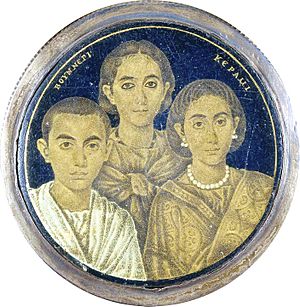
Gold glass is a technique where a layer of gold leaf with a design is placed between two layers of glass that are then fused together. This technique was developed in Hellenistic times and brought back in the 3rd century AD. Most of the surviving pieces are round bottoms of wine cups or glasses. These were used to mark and decorate graves in the Catacombs of Rome by pressing them into mortar. Most of these date from the 4th and 5th centuries. Many are Christian, but there are also pagan and Jewish examples. They were probably given as gifts for weddings or holidays.
The earlier gold glass pieces are "among the most vivid portraits to survive from Early Christian times." They show intense and serious faces and are the best examples of what high-quality Roman portraits could look like in paint. The Gennadios medallion in the Metropolitan Museum of Art is a great example of an Alexandrian portrait on blue glass. It uses a more complex technique and looks more natural than most later Roman examples.
Triumphal Paintings
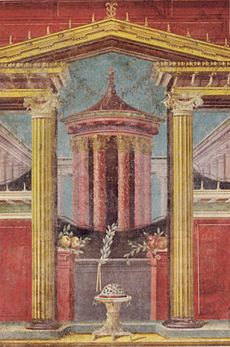
Starting in the 3rd century BC, a special type of painting called Triumphal Paintings appeared. These paintings showed parades after military victories, scenes from the war, and the lands and cities that were conquered. They even included simple maps to show important points of the campaign.
These paintings no longer exist, but they likely influenced the historical scenes carved on military sarcophagi, the Arch of Titus, and Trajan's Column. This shows how important landscape painting was, sometimes even looking like maps.
Sculpture
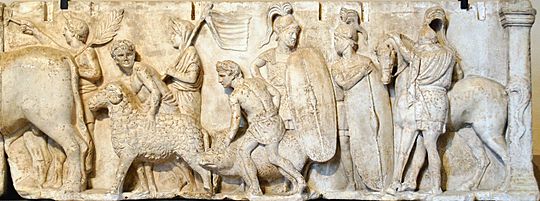
Early Roman art was influenced by Greek art and the art of the nearby Etruscans, who were also greatly influenced by the Greeks. The Etruscans were known for life-sized tomb statues made of terracotta, often showing people lying on top of a sarcophagus lid as if they were dining. As the Roman Republic grew and conquered Greek lands, Roman sculpture became an extension of the Hellenistic (Greek-influenced) style. By the 2nd century BC, most sculptors in Rome were Greek, often enslaved during conquests like that of Corinth in 146 BC. Many Greek statues were brought to Rome as war treasures or through trade.
A unique Italian style can be seen in the tomb monuments of wealthy middle-class Romans, which often featured portrait busts. Roman portraiture is considered the main strength of Roman sculpture. While we don't have the ancestral masks that were worn in funerals, many surviving busts likely represent family ancestors. The famous bronze head thought to be of Lucius Junius Brutus is a rare example of early Italian style. Imperial portraits were initially idealized, like those of Augustus.

Romans generally didn't try to compete with Greek free-standing sculptures of heroes. Instead, they created historical works in relief (sculpture that projects from a background). The most famous examples are the great Roman triumphal columns with continuous story-telling reliefs winding around them. These include Trajan's Column (113 AD) and the Column of Marcus Aurelius (by 193 AD) in Rome. The Ara Pacis ("Altar of Peace," 13 BC) shows the official Greco-Roman style at its most classic.
All kinds of small, luxury sculptures continued to be made, and their quality could be very high. Examples include the silver Warren Cup, the glass Lycurgus Cup, and large cameos like the Gemma Augustea. For many ordinary people, molded relief decorations on pottery vessels and small figurines were produced in large numbers and often with good quality.
After a "baroque" phase in the late 2nd century, Roman art in the 3rd century largely stopped producing sculpture in the classical style. Even the most important imperial monuments showed short, large-eyed figures in a harsh, front-facing style. This change is clearly seen in the Arch of Constantine (315 AD) in Rome. This arch combines sections in the new style with older Greco-Roman style pieces taken from other monuments. The Four Tetrarchs (around 305 AD) from Constantinople, now in Venice, also shows this new anti-classical style.
This change in style happened just before Christianity became the official religion of the Roman state. This led to the end of large religious sculptures. Large statues were then only made for emperors, like the huge Colossus of Constantine. However, wealthy Christians continued to order reliefs for sarcophagi, like the Sarcophagus of Junius Bassus. Very small sculptures, especially in ivory, were also continued by Christians.
-
Etruscan sarcophagus, 3rd century BC.
-
A Roman naval bireme depicted in a relief from the Temple of Fortuna Primigenia in Praeneste (Palastrina), built around 120 BC.
-
The Orator, around 100 BC, an Etrusco-Roman bronze statue depicting Aule Metele, an Etruscan man wearing a Roman toga.
-
Augustus of Prima Porta, statue of the emperor Augustus, 1st century AD, Vatican Museums.
-
Bust of Emperor Claudius, around 50 CE, (reworked from a bust of emperor Caligula), Vatican Museums.
-
The Four Tetrarchs, around 305 AD, showing the new anti-classical style, in porphyry, now San Marco, Venice.
-
Roman portraiture is known for its realism, showing people "warts and all."
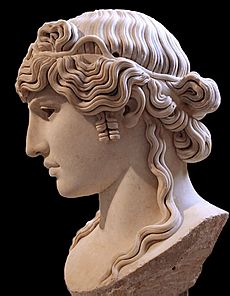
Roman sculpture is usually divided into five types: portraits, historical reliefs, funerary reliefs, sarcophagi, and copies of ancient Greek works. Many of these sculptures were large, colorful terra-cotta images, like the Apollo of Veii. However, the paint on many of them has worn away over time.
Narrative Reliefs
Greek sculptors often showed military achievements using mythological stories. The Romans, however, used a more documentary style. Roman reliefs of battle scenes, like those on the Column of Trajan, were made to glorify Roman power. They also provide a direct look at military clothing and equipment. Trajan's column tells the story of the Dacian wars fought by Trajan in what is now Romania. It is a top example of Roman historical relief and a great artistic treasure. This amazing work, over 650 feet long, shows not just realistic people (over 2,500 of them) but also landscapes, animals, and ships in a continuous visual story. It's like an ancient documentary movie!
Decorative Arts
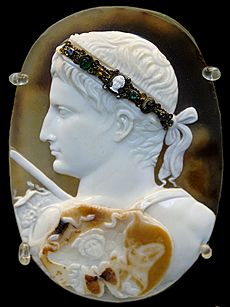
Pottery and Terracottas
The Romans had a long tradition of art in what are called "minor arts" or decorative art. Many of these were luxury items, but large numbers of terracotta figurines, both religious and everyday, continued to be made cheaply. Some larger Campana reliefs were also made from terracotta. Roman art didn't use vase-painting like the ancient Greeks, but Ancient Roman pottery vessels were often decorated with stylish molded reliefs. Producers of the millions of small oil lamps sold seem to have relied on attractive decoration to stand out. Almost every subject in Roman art, except landscape and portraiture, can be found on these miniature lamps.
Glass

Luxury arts included fancy Roman glass made with many different techniques. Many smaller types were probably affordable to a good number of Roman people. This was not true for the most expensive types of glass, like the cage cups or diatreta. The Lycurgus Cup in the British Museum is a rare example of a glass cup with figures that changes color when light shines through it. The Augustan Portland Vase is a masterpiece of Roman cameo glass. It copied the style of large engraved gems (Blacas Cameo, Gemma Augustea) and other hardstone carvings that were popular around that time.
Mosaic
Roman mosaic was a less important art form, though often very large, until the very end of the period. In the late 4th century, Christians started using mosaics for large religious images on the walls of their new churches. In earlier Roman art, mosaics were mainly used for floors, curved ceilings, and walls that might get wet. The famous copy of a Hellenistic painting in the Alexander Mosaic in Naples was originally on a floor in Pompeii. This is much higher quality work than most Roman mosaics. However, very fine panels, often of still life subjects made with tiny micromosaic tesserae, have also survived.
The Romans distinguished between normal opus tessellatum (mosaics with pieces mostly over 4 mm across, laid on site) and finer opus vermiculatum (for small panels, thought to be made in a workshop and brought to the site as a finished panel). The latter was a Greek style found in Italy between about 100 BC and 100 AD. Most signed mosaics have Greek names, suggesting the artists were mostly Greek, often slaves trained in workshops. The late 2nd century BC Nile mosaic of Palestrina is a very large example of the popular "Nilotic landscape" style, showing scenes from Egypt. The 4th century Gladiator Mosaic in Rome shows several large figures fighting. Orpheus mosaics, often very large, were another favorite subject for villas, showing fierce animals tamed by Orpheus's music.
Metalwork
Metalwork was very advanced and clearly a key part of wealthy homes. Rich Romans ate off silver plates, often drank from glass, and had detailed metal fittings on their furniture, jewelry, and small figurines. Several important hoards (collections of valuable items) found in the last 200 years, mostly from the more violent edges of the late empire, have given us a much clearer idea of Roman silver plate. The Mildenhall Treasure and Hoxne Hoard are both from England. Few examples of high-end ancient Roman furniture survive, but those that do show refined and elegant design.
Coins and Medals
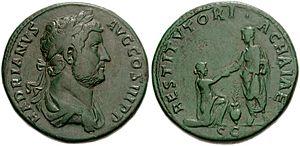
Few Roman coins reach the artistic level of the best Greek coins. However, they survive in huge numbers. Their images and inscriptions are a crucial source for studying Roman history and the development of imperial symbols. They also contain many fine examples of portraiture. Coins reached people across the entire Empire and beyond. In the Empire, medallions made of precious metals began to be produced in small numbers as gifts from the emperor. These are similar to coins but larger and usually more finely made. Coin images initially followed Greek styles, with gods and symbols. But during the end of the Republic, first Pompey and then Julius Caesar appeared on coins. Portraits of the emperor or his family became standard on imperial coins. The inscriptions were used for propaganda.
Architecture
It was in architecture that Roman art made its greatest breakthroughs. Because the Roman Empire covered such a large area and included many cities, Roman engineers developed ways to build on a grand scale, including using concrete. Huge buildings like the Pantheon and the Colosseum could not have been built with older materials and methods. Although concrete had been invented a thousand years earlier in the Near East, the Romans used it for their most impressive buildings and monuments. They took advantage of concrete's strength and low cost. The concrete core was covered with plaster, brick, stone, or marble, and decorative, colorful, and gold-gilded sculptures were often added to create a dazzling effect of power and wealth.
Because of these methods, Roman architecture is famous for how long it lasts. Many buildings are still standing, and some are even still in use, mostly buildings that were turned into churches. However, many ruins have had their marble coverings removed, leaving their concrete cores exposed. This makes them look smaller and less grand than they originally were, like the Basilica of Constantine.
During the Republican era, Roman architecture combined Greek and Etruscan elements. It also introduced new ideas like the round temple and the curved arch. As Roman power grew, the first emperors cleared away poor areas to build grand palaces on the Palatine Hill and nearby. This required new engineering methods and large-scale designs. Roman buildings were then grouped together in commercial, political, and social areas called forums. The Forum of Julius Caesar was the first, and the Forum Romanum is the most famous. The largest arena in the Roman world, the Colosseum, was finished around 80 AD. It could hold over 50,000 people, had retractable fabric roofs for shade, and could host huge gladiator contests and even mock naval battles. This masterpiece of Roman architecture shows Roman engineering skill and uses all three architectural styles: Doric, Ionic, and Corinthian. Less famous but just as important for most Romans were the five-story insula or city blocks, which were like apartment buildings and housed tens of thousands of Romans.
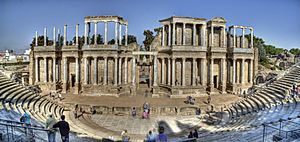
During the reigns of Trajan (98–117 AD) and Hadrian (117–138 AD), the Roman Empire was at its largest, and Rome itself was at its artistic peak. This was achieved through massive building programs of monuments, meeting houses, gardens, aqueducts, baths, palaces, and temples. The Roman use of the arch, concrete building methods, and the dome allowed for vaulted ceilings. This enabled the construction of public spaces and complexes, including the palaces, public baths, and basilicas of the "Golden Age" of the empire. Great examples of dome construction include the Pantheon, the Baths of Diocletian, and the Baths of Caracalla. The Pantheon (dedicated to all the planetary gods) is the best-preserved ancient temple with an intact ceiling featuring an open "eye" in the center. The height of the ceiling exactly matches the building's inner radius, creating a perfect dome. These grand buildings later inspired architects of the Italian Renaissance, like Brunelleschi. By the time of Constantine (306-337 AD), the last major building projects in Rome took place, including the Arch of Constantine built near the Colosseum. This arch reused some stone work from nearby, creating a mix of styles.
Roman aqueducts, also based on the arch, were common in the empire. They were essential for bringing water to large cities. Their standing stone remains are very impressive, such as the Pont du Gard (with three tiers of arches) and the aqueduct of Segovia. These structures stand as silent proof of their excellent design and construction.
See also
 In Spanish: Arte de la Antigua Roma para niños
In Spanish: Arte de la Antigua Roma para niños
- Art collection in ancient Rome
- Byzantine art
- Latin literature
- Music of ancient Rome
- Neoclassicism
- Pompeian Styles
- Roman graffiti


